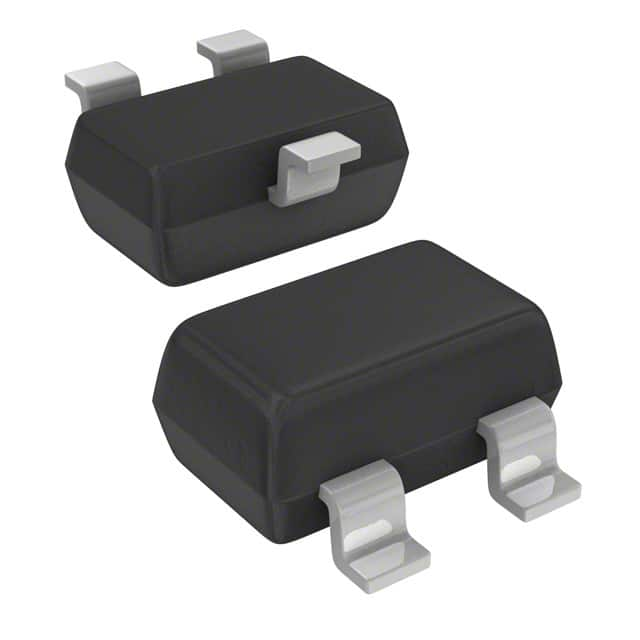HSMP-386C-TR1
Introduction
HSMP-386C-TR1 is a high-performance diode belonging to the category of surface mount PIN diodes. This component is widely used in various electronic applications due to its unique characteristics and versatile nature.
Basic Information Overview
- Category: Surface Mount PIN Diode
- Use: RF Switching, Attenuation, and Limiting
- Characteristics: High Frequency Operation, Low Distortion, Low Capacitance
- Package: SOT-23
- Essence: High-Speed Signal Control
- Packaging/Quantity: Tape and Reel, 3000 units per reel
Specifications
- Reverse Voltage: 100V
- Forward Current: 100mA
- Capacitance: 0.2pF at 0V, 1MHz
- Power Dissipation: 225mW
- Operating Temperature Range: -65°C to +150°C
Detailed Pin Configuration
The HSMP-386C-TR1 features a standard SOT-23 package with three pins: 1. Pin 1: Anode 2. Pin 2: Cathode 3. Pin 3: No Connection
Functional Features
- Fast Switching Speed
- Low Reverse Recovery Time
- High Linearity
- Low Distortion
Advantages and Disadvantages
Advantages
- Suitable for High-Frequency Applications
- Compact SOT-23 Package
- Low Capacitance
- High Reliability
Disadvantages
- Limited Power Handling Capacity
- Sensitive to ESD
Working Principles
The HSMP-386C-TR1 operates based on the principle of controlling the flow of RF signals through the diode's forward and reverse bias conditions. By applying appropriate bias voltages, the diode can be utilized for switching, attenuation, and limiting RF signals.
Detailed Application Field Plans
This diode finds extensive use in the following applications: - RF Switches - RF Attenuators - RF Limiters - High-Frequency Signal Control Circuits
Detailed and Complete Alternative Models
Some alternative models to HSMP-386C-TR1 include: - HSMS-286x Series - HSMP-381x Series - HSMP-389x Series
In conclusion, the HSMP-386C-TR1 is a crucial component in high-frequency signal control circuits, offering fast switching speed, low distortion, and high linearity. Its compact SOT-23 package and low capacitance make it suitable for various RF applications.
[Word Count: 334]
Listen Sie 10 häufige Fragen und Antworten im Zusammenhang mit der Anwendung von HSMP-386C-TR1 in technischen Lösungen auf
What is HSMP-386C-TR1?
- HSMP-386C-TR1 is a high-speed, low-capacitance diode commonly used in RF and microwave applications.
What are the key features of HSMP-386C-TR1?
- The key features include low capacitance, fast switching speed, and high linearity, making it suitable for high-frequency applications.
What are the typical applications of HSMP-386C-TR1?
- It is commonly used in mixers, modulators, demodulators, RF power detectors, and other high-frequency circuits.
What is the maximum operating frequency of HSMP-386C-TR1?
- The maximum operating frequency is typically in the GHz range, making it suitable for high-frequency designs.
What is the voltage rating of HSMP-386C-TR1?
- The voltage rating is typically around 20V, making it suitable for low-power applications.
How does HSMP-386C-TR1 compare to other diodes in its class?
- It offers lower capacitance and faster switching speed compared to many other diodes, making it ideal for high-frequency designs.
Can HSMP-386C-TR1 be used in high-power applications?
- No, it is not designed for high-power applications due to its low power handling capability.
What are the recommended layout considerations when using HSMP-386C-TR1?
- Proper grounding, controlled impedance traces, and minimizing parasitic elements are important for optimal performance.
Are there any temperature limitations for HSMP-386C-TR1?
- It is typically rated for operation within a certain temperature range, so thermal management is important in high-temperature environments.
Where can I find detailed application notes for using HSMP-386C-TR1 in technical solutions?
- Detailed application notes can be found on the manufacturer's website or in the product datasheet, providing guidance on circuit design, layout, and performance optimization.


